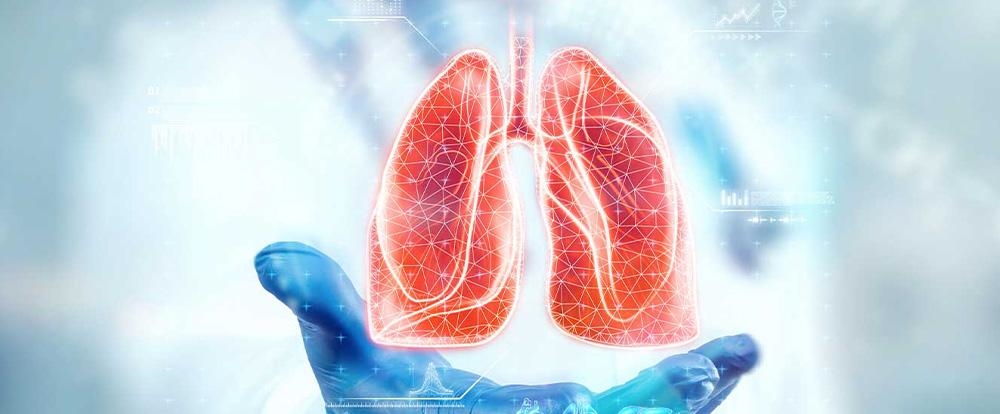Lung Resection

Our lungs are a pair of spongy organs located in our rib cage.
Oxygenated blood is pumped by the heart to circulate throughout the body. Meanwhile, tissues take up oxygen and nutrients in the blood, and the blood with low oxygen concentration flows back to the right heart and is finally pumped to the lungs.
The oxygen concentration of blood is increased in our lungs, and the wastes of the body's mechanism are excreted as carbon dioxide.
The right lung has three lobes, while the left is divided into two lobes. These lobes are also divided into pulmonary segments.
The blood vessels of the lungs are named according to this structural segmentation. The common pulmonary artery carries the dark or venous blood to the lungs, while the oxygenated blood flows to the left ventricle through the common pulmonary vein; the vasculature of the lungs is called lobar, bronchial, and segmental arteries and veins. A lung segment is a unit with its own artery, vein, and bronchus.
Lung resection can be carried out to treat pathologies that involve the lungs, lung cancers, and infections such as bronchiectasis or to collect biopsy specimens from the lung tissue.
Primary lung cancer implies cancers that originate from the tissues of the lungs. As the dark or venous blood is completely oxygenated and detoxified in the lungs, a tumor that develops in another organ can spread to the lungs through blood circulation or proximity. This type of cancer is called secondary or metastatic lung cancer.
For lung cancers, surgery is preceded by several treatment options, including but not limited to chemotherapy, radiotherapy, and targeted treatment. Suppose the criteria of surgery can be met, such as the removal of the tumor and the ability to survive with the rest of the healthy lung after the cancer is surgically removed. In that case, the thoracic surgeon may consider or recommend resection of the lung for the treatment of lung cancer.
The principal criterion for other pathologies requiring lung resection is whether the rest of the healthy lungs will be sufficient for survival.
For lung resection, a segment, a lobe, two lobes, or the whole lung can be resected or surgically removed, and a wedge-like part of the lung is removed (wedge resection). Excluding wedge resection, all options are commonly referred to as anatomic resection.
Thoracotomy implies the open surgery carried out for lung resection. If technical means or patient and disease factors (location and spread of the condition) allow, minimally invasive surgery, video thoracoscopic surgery and robotic surgery are other options.
As thoracotomy offers the best exposure, a long incision is made at the level of the fifth rib, and the lungs are exposed.
All lung resections are significant surgeries, so the patient should be very carefully prepped. A comprehensive physical examination follows a review of health history. Blood tests are planned in the light of signs and symptoms and biological examination data. Moreover, advanced imaging studies, such as CT, MRI, and PET/CT, are ordered to visualize the condition's stage and spread and plan the surgery.
Moreover, the patient is assessed by an anesthesiologist to manage anesthesia-related risks, and extra examinations are ordered if required.
For lobectomy, the patient is transferred to the operating suite, and an intravenous access line is inserted. A soothing agent is infused through this IV line to relax or calm down the patient. A tube is inserted into the throat of the patient to maintain breathing during the surgery. After anesthesia is administered, the patient is placed in the left lateral decubitus position if the right lung is resected, or the patient is placed in the correct lateral decubitus position if the left lung is resected. If open surgery (thoracotomy) is carried out, an incision, measuring approximately 25 cm in length, is made at the level of the 5th rib at the relevant side, and the lungs are exposed. Small incisions are made for video thoracoscopic and robotic surgeries, and ports are inserted through the incisions. While a camera is inserted through one of these ports, other ports insert surgical tools into the chest cavity.
After lobectomy, lobectomy, pneumonectomy (removal of right or left lung altogether), or wedge resection, two drains are placed, one at the apex of the lung and the other at the base. These drains drain fluid, blood, and air that may accumulate in the body after the surgery.
Finally, the large or small incisions are stitched and closed with wound dressing.
Lobectomy – Bilobectomy
Lobectomy implies the removal of a whole lobe of the lung due to a lung pathology or primary or metastatic cancer. As three lobes (upper, middle, and lower lobes) are present in the right lung, lobectomy refers to the simultaneous removal of the middle or, lower or upper lobe. Thoracotomy is the open surgery method; however, if technical means or patient and disease factors (location and spread of the condition) allow, minimally invasive surgery, video thoracoscopic surgery and robotic surgery are other options. The thoracic surgeon determines the best method regarding the patient and the condition by reviewing all criteria. Lobectomy is a significant surgery, and the artery that feeds the lobe and the vein that drains the dark blood in the lobe is tied and cut/divided. Next, the bronchi of the lobe are similarly cut, and the ends are closed. The lobe is dissected off the adjacent tissues and the nearby lobe.
After lobectomy operations, a cavity develops in the chest cavity, but it is filled in as the rest of the lobe(s) expand.
Segmentectomy
Lobes of the lungs are divided into units called segments. A lung segment is a lung unit with its artery, vein, and bronchus. Ten segments are present in the right lung, while eight in total are in the left lung. Segmentectomy is the minorest of the anatomic resections. The basic principle is to tie and cut the artery, the vein, and the bronchus of the segment, occlude the end that is left inside the body, and dissect off and obliterate the segment.
Pneumonectomy
Pneumonectomy refers to the total removal of the right or left lung. It is preferred mainly for lung cancer patients who fulfill the necessary criteria. In the case of pneumonectomy, patients should be far more closely monitored, and fluid intake and electrolytes should be carefully monitored and managed. Wedge resection: It implies anatomic resection of the lungs. This method is preferred for lung biopsies or removing lesions located at the periphery of the lungs. The periphery of the lungs is released in the form of a wedge or "V."





















